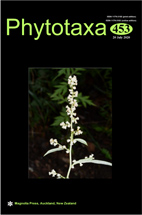Abstract
Pteris Linnaeus (1753: 1073) is the largest genus in Pteridaceae (PPG I 2016) and known to have 323 species globally (POWO 2020). It is a cosmopolitan genus with maximum diversity in tropical America, Africa and Asia but a few dwells in temperate regions too (Chao et al. 2014). The brake fern genus Pteris can be characterized from other members of Pteridaceae by its marginal indusiate sporangia borne continuously along most of the length of the pinnae from commissural veins and cingulate trilete spores (Prado & Windisch 2000).
References
<p class="Reference">Brogniart, A. (1836) <em>Histoire des végétaux fossiles, ou, recherches botaniques et geìologiques sur les veìgeìtaux renfermeìs dans les diverses couches du globe</em> 10. G. Dufour et Ed. D’Ocagne, Paris, pp. 337–368.</p><p class="Reference">Chao, Y.-S. Rouhan, G., Amoroso, V.B. & Chiou, W.-L. (2014) Molecular phylogeny and biogeography of the fern genus <em>Pteris</em> (Pteridaceae). <em>Annals of Botany</em> 114: 109–124.</p><p class="Reference"> <a href="https://doi.org/10.1093/aob/mcu086">https://doi.org/10.1093/aob/mcu086</a></p><p class="Reference">Doweld, A.B. (2015) <em>Cissus notabilis</em>, a new name for extant <em>Cissus spectabilis </em>(Vitaceae<em>)</em>. <em>Phytotaxa </em>231 (1): 99–100.</p><p class="Reference"> <a href="https://doi.org/10.11646/phytotaxa.231.1.11">https://doi.org/10.11646/phytotaxa.231.1.11</a></p><p class="Reference">Doweld, A.B. (2016) <em>Ficus changii</em>, <em>Ficus fengkaiensis</em>, <em>Ficus obtusatoides</em> and <em>Ficus tethyca</em> (Moraceae), new replacement names. <em>Kew Bulletin</em> 71 (29): 1–2.</p><p class="Reference"> <a href="https://doi.org/10.1007/s12225-016-9641-x">https://doi.org/10.1007/s12225-016-9641-x</a></p><p class="Reference">Ettingshausen, E. (1865) Fossile Pterideen. <em>Die Farnkräuter der Jetztwelt</em>. Wien, pp. 105–117.</p><p class="Reference">Govaerts, R. (2018) 101 Nomenclatural corrections in preparation for the Plants of the World Online. <em>Skvortsovia</em> 4 (3): 74–99.</p><p class="Reference">Hassler, M. & Schmitt, B.<strong> </strong>(2020) Checklist of Ferns and Lycophytes of the World. Version 8.30. Available from: <a href="http://worldplants.webarchiv.kit.edu/ferns/statistics.php"><span style="text-decoration: underline;">http://worldplants.webarchiv.kit.edu/ferns/statistics.php</span></a> (accessed 12 May 2020)</p><p class="Reference">IFPNI (2014-onwards) <em>The International Fossil Plant Names Index. Global registry of scientific names of fossil organisms covered by the International Code of Nomenclature for Algae, Fungi, and Plants (formerly International Code of Botanical Nomenclature) and International Code of Zoological Nomenclature. </em>Available from: <a href="http://fossilplants.info/">http://fossilplants.info/</a> (accessed 12 May 2020)</p><p class="Reference">Kottaimuthu, R.<strong> </strong>(2017) <em>Salix alexeii</em>, a new name for the extant <em>Salix elongata</em> L.He & Z.X.Zhang (Salicaceae). <em>Phytotaxa</em> 332 (3): 299–300.</p><p class="Reference"> <a href="https://doi.org/10.11646/phytotaxa.332.3.9">https://doi.org/10.11646/phytotaxa.332.3.9</a></p><p class="Reference">Kottaimuthu, R.<strong> </strong>(2019) <em>Diospyros minutisepala</em>, a new name for extant <em>Diospyros microcalyx </em>D.X.Nong & al. (Ebenaceae). <em>Annales Botanici Fennici</em> 56: 33–34.</p><p class="Reference"> <a href="https://doi.org/10.5735/085.056.0106">https://doi.org/10.5735/085.056.0106</a></p><p class="Reference">Kottaimuthu, R. & Jothi Basu, M. (2020) <em>Carex talbotii </em>(Cyperaceae), a replacement name for Berggren’s Sedge. <em>Phytotaxa</em> 447 (2): 146–148.</p><p class="Reference"> <a href="https://doi.org/10.11646/phytotaxa.447.2.7">https://doi.org/10.11646/phytotaxa.447.2.7</a></p><p class="Reference">Lesquereux, L. (1872) An enumeration with descriptions of some Tertiary fossil plants, from specimens procured in the explorations of Dr. F. V. Hayden, in 1870. <em>Annual report of the United States Geological Survey of the Territories 5(Supplement)</em>: 1–22.</p><p class="Reference"> <a href="https://doi.org/10.1111/jse.12229">https://doi.org/10.1111/jse.12229</a></p><p class="Reference">Linnaeus, C. (1753) <em>Species Plantarum </em>2<em>. </em>Laurentii Salvii, Holmiae, 1073 pp.</p><p class="Reference">Mickel, J.T. & Beitel, J.M. (1988) Pteridophyte flora of Oaxaca, Mexico. <em>Memoirs of the New York Botanical Garden</em> 46: 1–568.</p><p class="Reference">POWO (2020) <em>Pteris</em>. Available from: <a href="http://powo.science.kew.org">http://powo.science.kew.org</a> /taxon/ urn:lsid: ipni. org: names:328208-2#children (accessed 12 May 2020)</p><p class="Reference">PPG I (2016) A community-derived classification for extant lycophytes and ferns. <em>Journal of Systematics and Evolution</em> 54: 563–603. </p><p class="Reference"> <a href="https://doi.org/">https://doi.org/</a> 10.1111/jse.12229</p><p class="Reference">Prado, J. & Windisch, P.G. (2000) The genus <em>Pteris </em>L. (Pteridaceae) in Brazil. <em>Boletim do Instituto de Botânica </em>13: 103–199.</p><p class="Reference">Rakotondrainibe, F. & Jouy, A. (2016) Nouveautés taxonomiques et nomenclaturales dans le genre <em>Pteris </em>L. (Pteridaceae) à Madagascar.<strong> </strong><em>Adansonia</em> 38: 15–28.</p><p class="Reference"> <a href="https://doi.org/10.5252/a2016n1a2">https://doi.org/10.5252/a2016n1a2</a></p><p class="Reference">Turland, N.J., Wiersema, J.H., Barrie, F.R., Greuter, W., Hawksworth, D.L., Herendeen, P.S., Knapp, S., Kusber, W.H., Li, D.Z., Marhold, K., May, T.W., McNeill, J., Monro, A.M., Prado, J., Price, M.J. & Smith, G.F. (Eds.) (2018) <em>International Code of Nomenclature for algae, fungi, and plants (Shenzhen Code) adopted by the Nineteenth International Botanical Congress Shenzhen, China, July 2017</em>. <em>Regnum Vegetabile </em>159. Koeltz Botanical Books, Glashütten.</p><p class="Reference"> <a href="https://doi.org/10.12705/Code.2018">https://doi.org/10.12705/Code.2018</a></p><p class="Reference">Turner, I. (2014) Names of extant angiosperm species that are illegitimate homonyms of fossils. <em>Annales Botanici Fennici </em>51: 305–317.</p><p> <a href="https://doi.org/10.5735/085.051.0506">https://doi.org/10.5735/085.051.0506</a></p>

